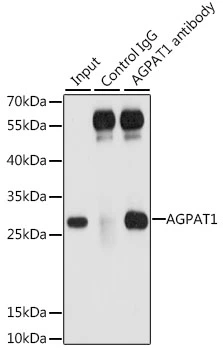
IP analysis of 293T cell lysate using GTX55496 AGPAT1 antibody. Antibody amount : 3microg / 200microg lysate Dilution : 1:1000
AGPAT1 antibody
GTX55496
ApplicationsImmunoPrecipitation, Western Blot, ImmunoHistoChemistry, ImmunoHistoChemistry Frozen
Product group Antibodies
ReactivityHuman, Mouse, Rat
TargetAGPAT1
Overview
- SupplierGeneTex
- Product NameAGPAT1 antibody
- Delivery Days Customer9
- Application Supplier NoteWB: 1:500 - 1:2000. IP: 1:50 - 1:100. *Optimal dilutions/concentrations should be determined by the researcher.Not tested in other applications.
- ApplicationsImmunoPrecipitation, Western Blot, ImmunoHistoChemistry, ImmunoHistoChemistry Frozen
- CertificationResearch Use Only
- ClonalityPolyclonal
- ConjugateUnconjugated
- Gene ID10554
- Target nameAGPAT1
- Target description1-acylglycerol-3-phosphate O-acyltransferase 1
- Target synonyms1-acylglycerol-3-phosphate O-acyltransferase 1 (acetoacetly Coenzyme A thiolase); 1-acylglycerol-3-phosphate O-acyltransferase 1 (lysophosphatidic acid acyltransferase, alpha); 1-acyl-sn-glycerol-3-phosphate acyltransferase alpha; 1-AGP acyltransferase 1; 1-AGPAT 1; 1-AGPAT1; epididymis secretory sperm binding protein; G15; LPAATA; LPAAT-alpha; lysophosphatidic acid acyltransferase alpha; lysophospholipid acyltransferase
- HostRabbit
- IsotypeIgG
- Protein IDQ99943
- Protein Name1-acyl-sn-glycerol-3-phosphate acyltransferase alpha
- Scientific DescriptionThis gene encodes an enzyme that converts lysophosphatidic acid (LPA) into phosphatidic acid (PA). LPA and PA are two phospholipids involved in signal transduction and in lipid biosynthesis in cells. This enzyme localizes to the endoplasmic reticulum. This gene is located in the class III region of the human major histocompatibility complex. Alternative splicing results in two transcript variants encoding the same protein. [provided by RefSeq, Jul 2008]
- ReactivityHuman, Mouse, Rat
- Storage Instruction-20°C or -80°C,2°C to 8°C
- UNSPSC12352203
References
- Exercise promotes angiogenesis by enhancing endothelial cell fatty acid utilization via liver-derived extracellular vesicle miR-122-5p. Lou J et al., 2022 Jul, J Sport Health SciRead more

